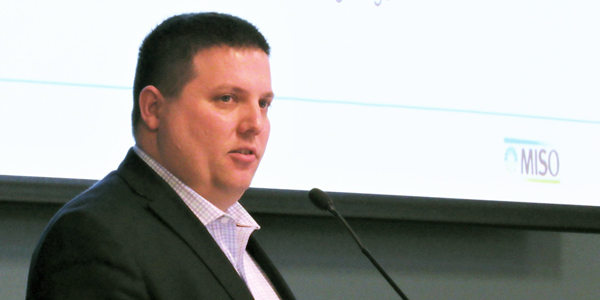By Amanda Durish Cook
MISO is moving ahead with a proposal to largely recycle last year’s 15-year transmission planning predictions for use in its 2019 Transmission Expansion Plan, but some stakeholders are urging the RTO to at least expand the plan.
During a March 20 workshop to gather stakeholder input on MTEP 19, MISO Planning Manager Tony Hunziker said the futures were developed for reuse over multiple planning cycles, with small updates to cover uncertainties such as the capital cost of building generation, demand growth rate and projected fuel prices. (See MISO: Minimal Change to 2019 Tx Planning Futures.) Stakeholders generally support the idea, he said.
MISO last year created four future scenarios for use in MTEP planning, including:
- A limited fleet change future, in which the fleet remains relatively static with coal units retiring at the end of their useful life;
- A continued fleet change scenario, in which the grid develops according to the trends of the past decade;
- An accelerated fleet change future driven by a strong economy that increases demand and motivates carbon regulations and increased renewable use; and
- A future in which distributed and emerging technologies become more widely used.
MISO planners are proposing small adjustments to some MTEP 19 assumptions, namely to account for sluggish load and higher-than-expected renewable penetration.
With energy growth currently outpacing load growth, planners say MISO should abandon its previous practice of assuming energy will grow at 0.5 to 1.5 times the base growth rate (extrapolated from load-serving entities’ current forecasts) in its transmission planning, and instead plan for anything from no growth to twice the base growth rate. Preliminary demand forecasts from LSEs show a 0.3% average growth rate through 2027, down from 0.5% in MTEP 18 and 0.6% in MTEP 19, while energy is expected to grow at a 0.5% rate.
MISO staff are also considering raising projected renewable penetration by 5% across all futures — from 10-30% to 15-35% of capacity. They acknowledged that the low end of the MTEP 18 range does not reflect the number of renewables on track to complete the interconnection queue.
The RTO also plans to update its base futures model to include planned units holding a certificate of public convenience and necessity, as well as units that have a signed generator interconnection agreement.
MISO will take stakeholder input on MTEP 19 futures through April 20 and expects to have futures finalized by September.
Fifth Future
But some stakeholders are asking MISO to create of a fifth future. Investment firm Veriquest requested the RTO develop an additional scenario that focuses on the regional siting of distributed resources, while MISO’s Environmental sector asked for a standalone future showing how possible federal or state carbon regulations drive fleet evolution.
Veriquest’s David Harlan said he’d like to see futures more informed by future capacity needs.
“I still don’t have a good picture where the source of needs is and where the capacity is,” Harlan said. He urged MISO planners to make projections to share with stakeholders about who benefits from cost-effective transmission requirements to move wind from North Dakota to Mississippi, for example.
“None of that is visible in this process,” Harlan said.
MISO Director of Policy Studies J.T. Smith said the RTO does account for future capacity movement when building MTEP models.
The Transmission Owners sector said the potential industry changes depicted in the four MTEP futures adequately capture future impacts to the transmission system. “While some of the currently defined futures, such as the limited fleet change, may not align well with the current industry projections, those futures provide valuable information … as well as provide a counter to the more aggressive generation change assumptions implemented in other futures,” it said.
Apex Clean Energy’s Richard Seide asked if MISO is accounting for commitments from utilities that intend to eliminate the use of coal, such as Consumers Energy, which recently announced its plans to go coal-free by 2040. (See CMS Energy Plans a Zero-Coal Future by 2040.)
“I don’t know how to say it, but the world has changed … and it occurred very quickly. You’re sitting on the largest queue ever,” Seide said.
Shane O’Brien, of MISO’s resource forecasting group, said stakeholders have so far said the RTO’s retirement projections are adequate. The RTO does not hold utilities to retirement announcements or include them in planning until owners submit Attachment Y retirement notices.





